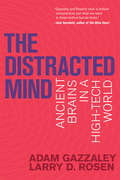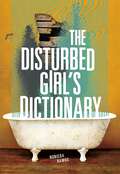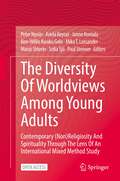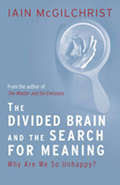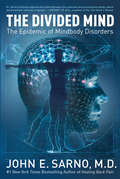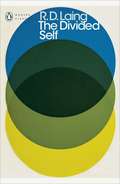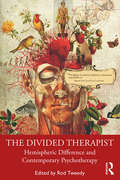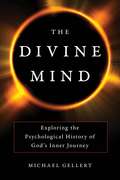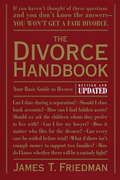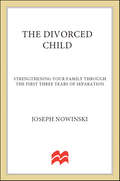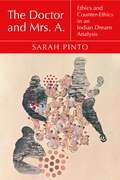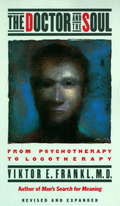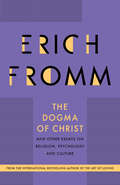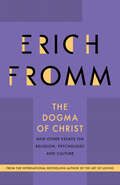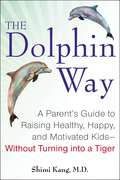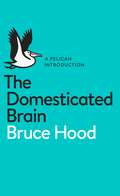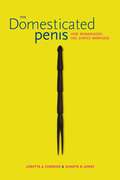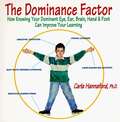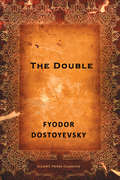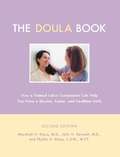- Table View
- List View
The Distracted Mind: Ancient Brains in a High-Tech World
by Adam Gazzaley Larry D. RosenWhy our brains aren't built for media multitasking, and how we can learn to live with technology in a more balanced way."Brilliant and practical, just what we need in these techno-human times."—Jack Kornfield, author of The Wise HeartMost of us will freely admit that we are obsessed with our devices. We pride ourselves on our ability to multitask—read work email, reply to a text, check Facebook, watch a video clip. Talk on the phone, send a text, drive a car. Enjoy family dinner with a glowing smartphone next to our plates. We can do it all, 24/7! Never mind the errors in the email, the near-miss on the road, and the unheard conversation at the table. In The Distracted Mind, Adam Gazzaley and Larry Rosen—a neuroscientist and a psychologist—explain why our brains aren't built for multitasking, and suggest better ways to live in a high-tech world without giving up our modern technology.The authors explain that our brains are limited in their ability to pay attention. We don't really multitask but rather switch rapidly between tasks. Distractions and interruptions, often technology-related—referred to by the authors as “interference”—collide with our goal-setting abilities. We want to finish this paper/spreadsheet/sentence, but our phone signals an incoming message and we drop everything. Even without an alert, we decide that we “must” check in on social media immediately.Gazzaley and Rosen offer practical strategies, backed by science, to fight distraction. We can change our brains with meditation, video games, and physical exercise; we can change our behavior by planning our accessibility and recognizing our anxiety about being out of touch even briefly. They don't suggest that we give up our devices, but that we use them in a more balanced way.
The Disturbed Girl's Dictionary
by NoNieqa RamosA 2019 YALSA Best Fiction for Young Adults Selection A 2018 New York Public Library Best Book for Teens Macy's school officially classifies her as "disturbed," but Macy isn't interested in how others define her. She's got more pressing problems: her mom can't move off the couch, her dad's in prison, her brother's been kidnapped by Child Protective Services, and now her best friend isn't speaking to her. Writing in a dictionary format, Macy explains the world in her own terms—complete with gritty characters and outrageous endeavors. With an honesty that's both hilarious and fearsome, slowly Macy reveals why she acts out, why she can't tell her incarcerated father that her mom's cheating on him, and why her best friend needs protection . . . the kind of protection that involves Macy's machete.
The Diversity Of Worldviews Among Young Adults: Contemporary (Non)Religiosity And Spirituality Through The Lens Of An International Mixed Method Study
by Paul Stenner Mika T. Lassander Sofia Sjö Peter Nynäs Ariela Keysar Janne Kontala Ben-Willie Kwaku Golo Marat ShterinThis open access volume features a data-rich portrait of what young adults think about the world. It collects the views of students in higher education from various cultural regions, religious traditions, linguistic groups, and political systems. This will help readers better understand a generation that will soon rise to power and influence.The analysis focuses on 12 countries. These include Canada, China, Finland, Ghana, India, Israel, Peru, Poland, Russia, Sweden, Turkey, and the USA. It employs a mixed-methods approach, invested in the study of an individual's views and values using state-of-the-art methodology, including the innovative Faith Q-sort. This instrument is new to the field and developed for assessing the entanglement of subjective views and personal beliefs. The study also incorporates a comprehensive values survey as well as other survey tools that look into people's social capital, media use, social values alignment, and subjective well-being. Each chapter is co-authored by an international team of scholars with research interest in the particular topic. The rationale for this principle is the need to engage individuals from different cultural backgrounds, scholarly disciplines, and methodological and substantive competences. In the end, this innovative approach presents an informed, empirically grounded analysis of the values and worldviews of the future generation. It sheds an important light on how changes in the religious landscape are intertwined with broad and diffuse processes of socio-economic and global cultural change.
The Divided Brain and the Search for Meaning
by Iain McgilchristIn this 10,000-word essay, written to complement Iain McGilchrist's acclaimed The Master and His Emissary, the author asks why - despite the vast increase in material well-being - people are less happy today than they were half a century ago, and suggests that the division between the two hemispheres of the brain has a critical effect on how we see and understand the world around us. In particular, McGilchrist suggests, the left hemisphere's obsession with reducing everything it sees to the level of minute, mechanistic detail is robbing modern society of the ability to understand and appreciate deeper human values. Accessible to readers who haven't yet read The Master and His Emissary as well as those who have, this is a fascinating, immensely thought-provoking essay that delves to the very heart of what it means to be human.
The Divided Mind
by John E. SarnoThe book that will change the way we think about health and illness, The Divided Mind is the crowning achievement of Dr. John E. Sarno's distinguished career as a groundbreaking medical pioneer, going beyond pain to address the entire spectrum of psychosomatic (mindbody) disorders. The interaction between the generally reasonable, rational, ethical, moral conscious mind and the repressed feelings of emotional pain, hurt, sadness, and anger characteristic of the unconscious mind appears to be the basis for mindbody disorders. The Divided Mind traces the history of psychosomatic medicine, including Freud's crucial role, and describes the psychology responsible for the broad range of psychosomatic illness. The failure of medicine's practitioners to recognize and appropriately treat mindbody disorders has produced public health and economic problems of major proportions in the United States. One of the most important aspects of psychosomatic phenomena is that knowledge and awareness of the process clearly have healing powers. Thousands of people have become pain-free simply by reading Dr. Sarno's previous books. How and why this happens is a fascinating story, and is revealed in The Divided Mind.
The Divided Self: An Existential Study in Sanity and Madness
by R. D. LaingDr. Laing's first purpose is to make madness and the process of going mad comprehensible.
The Divided Self: An Existential Study in Sanity and Madness (Penguin Modern Classics)
by R. D. LaingThe Divided Self, R.D. Laing's groundbreaking exploration of the nature of madness, illuminated the nature of mental illness and made the mysteries of the mind comprehensible to a wide audience. First published in 1960, this watershed work aimed to make madness comprehensible, and in doing so revolutionized the way we perceive mental illness. Using case studies of patients he had worked with, psychiatrist R. D. Laing argued that psychosis is not a medical condition, but an outcome of the 'divided self', or the tension between the two personas within us: one our authentic, private identity, and the other the false, 'sane' self that we present to the world. Laing's radical approach to insanity offered a rich existential analysis of personal alienation and made him a cult figure in the 1960s, yet his work was most significant for its humane attitude, which put the patient back at the centre of treatment.Includes an introduction by Professor Anthony S. David.'One of the twentieth century's most influential psychotherapists' Guardian'Laing challenged the psychiatric orthodoxy of his time ... an icon of the 1960s counter-culture' The Times
The Divided Therapist: Hemispheric Difference and Contemporary Psychotherapy
by Rod TweedyThis important new book explores the nature of the divided brain and its relevance for contemporary psychotherapy. Citing the latest neuroscientific research, it shows how the relationship between the two hemispheres of the brain is central to our mental health, and examines both the practical and theoretical implications for therapy. Disconnections, dissociations, and imbalances between our two hemispheres underlie many of our most prevalent forms of mental distress and disturbance. These include issues of addiction, autism, schizophrenia, depression, anorexia, relational trauma, borderline and personality disorders, psychopathy, anxiety, derealisation and devitalisation, and alexithymia. A contemporary understanding of the nature of the divided brain is therefore of importance in engaging with and treating these disturbances. Featuring contributions from some of the key authors in the field, The Divided Therapist suggests that hemispheric integration lies at the heart of the therapeutic process itself, and that a better understanding of the precise mechanisms that underlie and enable this integration will help to transform the practice of psychotherapy and psychoanalysis in the twenty-first century. The book will be essential reading for any therapeutic practitioner interested in how the architecture of the brain informs and effects their client’s issues and challenges.
The Divine Art of Dying
by Karen Speerstra Herbert Anderson foreword by Ira ByockThe Divine Art of Dying looks at the unique moment when a person turns toward death and examines what the dying person and their caregivers can expect. Based on the author’s own current experience, it’s about how we might die well and live well up to the very end of our physical existence. Combining personal stories with solid research on palliative and hospice care, this book identifies the decisions the dying one and his or her loved ones and friends must make. Unlike other books on dying, The Divine Art of Dying takes a broader approach than just a medical one. It is not a “case book” but rather a well integrated look at the divine art of living and dying to the fullest, that includes spiritual insights from many sources along with references from literature, movies, and current culture. Karen Speerstra is an award-winning author. Her previous Divine Arts title Sophia: The Feminine Face of God (ISBN: 978-1611250046) won the 2013 Nautilus gold award. Written in a very readable style, The Divine Art Of Dying addresses real and common fears and the challenges of letting go and handing over a life. The book introduces new concepts to the body of writing on death and dying. It explains the medical complexities of end-of-life choices and gives helpful advice to caregivers to the dying in every chapter. and authentically chronicles the author’s own dying process. Foreword by author and internationally recognized authority on hospice and palliative care Dr. Ira Byock.
The Divine Magician: The Disappearance of Religion and the Discovery of Faith
by Peter RollinsIn this mind-bending exploration of traditional Christianity, firebrand Peter Rollins turns the tables on conventional wisdom, offering a fresh perspective focused on a life filled with love.Peter Rollins knows one magic trick—now, make sure you watch closely. It has three parts: the Pledge, the Turn, and the Prestige. In Divine Magician, each part comes into play as he explores a radical view of interacting with the world in love. Rollins argues that the Christian event, reenacted in the Eucharist, is indeed a type of magic trick, one that is echoed in the great vanishing acts performed by magicians throughout the ages. In this trick, a divine object is presented to us (the Pledge), disappears (the Turn), and then returns (the Prestige). But just as the returned object in a classic vanishing act is not really the same object—but another that looks the same—so this book argues that the return of God is not simply the return of what was initially presented, but rather a radical way of interacting with the world. In an effort to unearth the power of Christianity, Rollins uses this framework to explain the mystery of faith that has been lost on the church. In the same vein as Rob Bell&’s bestseller Love Wins, this book pushes the boundaries of theology, presenting a stirring vision at the forefront of re-imagined modern Christianity. As a dynamic speaker as he is in writing, Rollins examines traditional religious notions from a revolutionary and refreshingly original perspective. At the heart of his message is a life lived through profound love. Just perhaps, says Rollins, the radical message found in Christianity might be one that the church can show allegiance to.
The Divine Mind: Exploring the Psychological History of God's Inner Journey
by Michael GellertA Jungian psychoanalyst with a background in Judaism and Zen Buddhism explores the history of God concepts in the Judeo-Christian and Islamic traditions.This book is about the Abrahamic God’s inner journey, an epic that begins in the Hebrew Bible—the common source of Judaism, Christianity, and Islam. This God emerges as a living, textured personality as tormented as a Shakespearean character and as divided against humanity as the devil who personifies his dark side. Yet in heroic fashion, he embarks on a journey to greater consciousness, stretching into himself in the Talmud, New Testament, Qur’an, and Gnostic writings. Then finally, with and through the Jewish, Christian, and Islamic mystics, he discovers his true self as the absolute Godhead. He takes up residence in their psyches as their own Divine Mind or true self. The book suggests that what God learned from his journey might be something that we in turn could learn from and that could help us at the dawn of the twenty-first century. In this way, God’s inner journey becomes a metaphor for our own. Michael Gellert, a Jungian psychoanalyst, treats this story and the sacred writings that convey it as psychological facts—as expressions of the human psyche—regardless of whether or not God actually exists. He shows how the Hebrew Bible presents God as a primitive, barbaric tribal war god while centuries later the mystics portray him as their innermost essence and emptied of all projected, external, anthropomorphic images. Thus, God’s inner journey and the evolution of human consciousness—his story and ours—parallel each other and are integrally related. Rich in historical detail and psychological insights, this is a book that will be welcomed by seekers of every background and orientation.
The Divorce Handbook
by Pamela Painter James T. Friedman Enid Levinge PowellSince its first publication in 1982, The Divorce Handbook has sold over 200,000 copies. In this new and fully revised edition, specialist in family law James T. Friedman covers, in an easy-to-use question-and-answer format, all the issues involved in negotiating a separation and divorce--how to choose a lawyer; how to arrange child custody, support, and visitation; how to prevent financial hide-and-seek; what to expect of the divorce proceedings themselves; and what to do if the divorce goes to trial. This revised edition addresses current trends in such areas as divorce law, alimony, property division, shared parenting, and visitation; it includes an expanded section of checklists, schedules, and guides for reconciliation and child support, as well as attorney retainer agreements, asset/liability worksheets, and more.The American Bar Association has called The Divorce Handbook "a welcome breath of fresh air in an otherwise stifling atmosphere created by a virtual avalanche of books about divorce." The revised edition of The Divorce Handbook is your best guide through the traumatic and painful business of divorce, and will be an essential resource for years to come.From the Trade Paperback edition.
The Divorce Remedy: The Proven 7-step Program For Saving Your Marriage
by Michele Weiner DavisMichele Weiner-Davis offers an empowering and encouraging guide for revitalizing marriage and building stronger, more loving bonds. <P><P> Michele Weiner-Davis goes beyond her marriage-saving bestseller, Divorce Busting, with this empowering and encouraging guide for revitalizing marriage and building stronger, more loving bonds. In a down-to-earth style that is free of psychobabble, Weiner-Davis outlines a realistic, solution-oriented seven-step program for managing marital problems, which, when left unchecked, can drain the life out of a relationship. Using revealing anecdotes and in-depth case studies, she illustrates practical ways for marriage partners to <P><P> <br>-avoid the “divorce trap” <br>-identify specific marriage-saving goals <br>-move beyond ineffective, hurtful ways of interacting <br>-become an expert on “doing what works” <br>-overcome infidelity, Internet obsessions, depression, sexual problems, and midlife crises <br>-get your marriage back on track—and keep it there <P><P>Rescue your marriage with the proven techniques of The Divorce Remedy—sound, sensible advice from a renowned relationship expert!
The Divorced Child: Strengthening Your Family through the First 3 Years of Separation
by Joseph NowinskiDivorce is a reality of today's family life, but clinical research has shown that it is possible to mitigate its negative effects on children. Dr. Joseph Nowinski, a family therapist with over 20 years of experience treating families, argues that there is a three-year window in which to acclimate children to the change in family life. Combining case studies with new research, Dr. Nowinski gives parents the information and the tools to work through the transition. Written in a warm and authoritative tone, Nowinski will teach parents to:· Focus on your child's new day-to-day reality· Identify early signs of trouble· Help your child through the separation process and help them develop coping skills that will remain with them through life
The Doctor and Mrs. A.: Ethics and Counter-Ethics in an Indian Dream Analysis (Thinking from Elsewhere)
by Sarah PintoJust before India’s independence, a young Punjabi woman, ill at ease in her marriage and eager for personal and national freedom, sat down with psychiatrist Dev Satya Nand for an experiment in his new method of dream analysis. The published analysis documents a surge of emotion and reflections on sexuality, gender, marriage, ambition, trauma, and art. “Mrs. A.” (as she is known) turned to female figures from Hindu myth to reimagine her social world and its ethical arrangements, envisioning a future beyond marriage, colonial rule, and gendered constraints.This book explores the conversation between Mrs. A. and Satya Nand, its window onto gender and sexuality in late colonial Indian society, and the ways Mrs. A. put ethics in motion, creating alternatives to ideals of belonging, recognition, and consciousness. It finds in Mrs. A.’s musings repertoires for the creative transformation of ideals and explores the possibilities of thinking with a dynamic concept of counter-ethics. An unconventional history of gender and sexuality in late colonialism, this book reminds us that the west did not invent feminism, that psychiatry’s history of innovation and creativity is global, and that ethical thinking does not need to center on western myths or paradigms.
The Doctor and the Soul: From Psychotherapy to Logotherapy (Pelican Ser.)
by Viktor E. FranklEmphasizing spiritual values and the quest for meaning in life in its approach to the neurotic behavior, by the founder of logotherapy. Copyright © Libri GmbH. All rights reserved.
The Dogma of Christ
by Erich FrommThe essays in this fascinating volume examine present-day psychological and cultural problems with the keen insight and humanistic sympathies characteristic of Erich Fromm's work. The Dogma of Christ and Other Essays provides some of the sharpest critical insights into how the contemporary world of human destructiveness and violence can no longer separate religion, psychology and politics. The book brilliantly summarizes Fromm's ideas on how culture and society shape our behavior.
The Dogma of Christ: And Other Essays on Religion, Psychology and Culture (Routledge Classics Ser.)
by Erich Fromm&“Fromm&’s developing thought merits the critical attention of all concerned with the human condition and its future.&” —The Washington Post The essays in this fascinating volume examine present-day psychological and cultural problems with the keen insight and humanistic sympathies characteristic of Erich Fromm&’s work.The Dogma of Christ provides some of the sharpest critical insights into how the contemporary world of human destructiveness and violence can no longer separate religion, psychology, and politics. The book brilliantly summarizes Fromm&’s ideas on how culture and society shape our behavior. &“It&’s the new post-religious theme song. The Fromm exhortations are imaginative and he has a definite audience.&” —Kirkus Reviews &“Of all the psychological theorists who have tried to formulate a system better than Freud&’s to approach problems of contemporary life, no one has been more creative or influential than Erich Fromm. He is the most articulate advocate on the role of social forces in molding our character and on our manner of relating to others. This volume is an expansion of his systematic doctrine.&” —Louis L. Lunsky, MD, Archives of Internal Medicine
The Dolphin Way
by Shimi KangIn this inspiring book, Harvard-trained child and adult psychiatrist and expert in human motivation Dr. Shimi Kang provides a guide to the art and science of inspiring children to develop their own internal drive and a lifelong love of learning. Drawing on the latest neuroscience and behavioral research, Dr. Kang shows why pushy "tiger parents" and permissive "jellyfish parents" actually hinder self-motivation. She proposes a powerful new parenting model: the intelligent, joyful, playful, highly social dolphin. Dolphin parents focus on maintaining balance in their children's lives to gently yet authoritatively guide them toward lasting health, happiness, and success. As the medical director for Child and Youth Mental Health community programs in Vancouver, British Columbia, Dr. Kang has witnessed firsthand the consequences of parental pressure: anxiety disorders, high stress levels, suicides, and addictions. As the mother of three children and as the daughter of immigrant parents who struggled to give their children the "best" in life--Dr. Kang's mother could not read and her father taught her math while they drove around in his taxicab--Dr. Kang argues that often the simplest "benefits" we give our children are the most valuable. By trusting our deepest intuitions about what is best for our kids, we will in turn allow them to develop key dolphin traits to enable them to thrive in an increasingly complex world: adaptability, community-mindedness, creativity, and critical thinking. Life is a journey through ever-changing waters, and dolphin parents know that the most valuable help we can give our children is to assist them in developing their own inner compass. Combining irrefutable science with unforgettable real-life stories, The Dolphin Way walks readers through Dr. Kang's four-part method for cultivating self-motivation. The book makes a powerful case that we are not forced to choose between being permissive or controlling. The third option--the option that will prepare our kids for success in a future that will require adaptability--is the dolphin way.
The Domesticated Brain: A Pelican Introduction (Pelican Books)
by Bruce HoodWhat makes us social animals? Why do we behave the way we do?How does the brain influence our behaviour? The brain may have initially evolved to cope with a threatening world of beasts, limited food and adverse weather, but we now use it to navigate an equally unpredictable social landscape. In The Domesticated Brain, renowned psychologist Bruce Hood explores the relationship between the brain and social behaviour, looking for clues as to origins and operations of the mechanisms that keep us bound together. How do our brains enable us to live together, to raise children, and to learn and pass on information and culture? Combining social psychology with neuroscience, Hood provides an essential introduction to the hidden operations of the brain, and explores what makes us who we are.
The Dominance Factor: How Knowing Your Dominant Eye, Ear, Brain, Hand and Foot Can Improve Your Learning
by Carla HannafordNeuroscientist and educator Dr. Carla Hannaford fascinating frontier (study) of knowledge about ... and its impact on learning and thinking at an ages. Her earlier book, Smart Moves, Why Learning Is Not All In Your Head, has been hailed for its insights into the body's role in learning. Joseph Chilton Pearce calls it "a major work of profound importance to our understanding of child development and education." In The Dominance Factor she explores an area that has long intrigued scientists and educators: the linkages between the side of the body we favor for seeing, hearing, touching, and moving and the way we think, learn, work, play, and relate to others. Your Dominance Profile is actually a key factor in shaping the way you think and act. Carla Hannaford shows why, and reveals how knowing your Profile will help you, and your children, to learn in the way that suits you best, and perform at your highest level. The Dominance Factor clearly explains methods for discovering your Profile that are so simple, non-invasive and easy to learn that even a child can do them. This is a book that parents, teachers, and all of us who need to understand what makes ourselves and others tick, will use and enjoy.
The Double
by Fyodor DostoyevskyAfter an uncomfortable and embarrassing evening at a party, the unsociable Golyadkin meets his double and soon discovers that this more charming and successful version of himself intends to take over his life and drive him to the edge of sanity.
The Double: A Psychoanalytic Study
by Harry Tucker Otto RankAlive, fresh, and stimulating, the theme of The Double comprises the issues of identity, narcissism, and the fear of death--actually the core of human existence. Rank's book is primarily a study of the double as it appeared in striking examples in German, French, Russian, English, and American literature from Goethe to Oscar Wilde.Originally published in 1971.A UNC Press Enduring Edition -- UNC Press Enduring Editions use the latest in digital technology to make available again books from our distinguished backlist that were previously out of print. These editions are published unaltered from the original, and are presented in affordable paperback formats, bringing readers both historical and cultural value.
The Doula Book: How a Trained Labor Companion Can Help You Have a Shorter, Easier, and Healthier Birth
by Marshall H. Klaus John H. Kennell Phyllis H. KlausMore and more parents-to-be all over the world are choosing the comfort and reassuring support of birth with a trained labor companion called a "doula. " This warm, authoritative, and irreplaceable guide completely updates the authors' earlier book, Mothering the Mother, and adds much new and important research. In addition to basic advice on finding and working with a doula, the authors show how a doula reduces the need for cesarean section, shortens the length of labor, decreases the pain medication required, and enhances bonding and breast feeding. The authors, world-renowned authorities on childbirth with combined experience of over 100 years working with laboring women, have made their book indispensable to every woman who wants the healthiest, safest, and most joyful possible birth experience.
